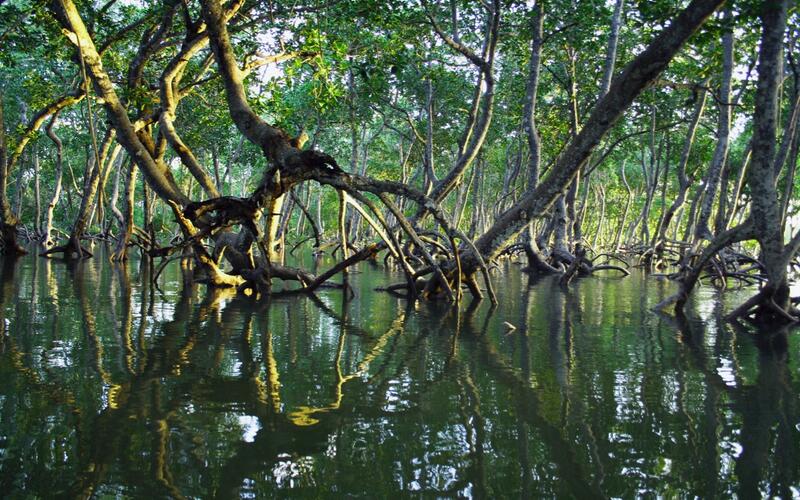From Air to Ocean: Coastal Ecosystem Restoration Permanently Removes Atmospheric Carbon Dioxide.

From Air to Ocean: Coastal Ecosystem Restoration Permanently Removes Atmospheric Carbon Dioxide.
Enhancing natural carbon storage is an important strategy to address climate change. A new study in Nature examines how coastal ecosystem restoration enhances the ocean’s ability to store carbon.
Fakhraee, M., Planavsky, N.J. & Reinhard, C.T. Ocean alkalinity enhancement through the restoration of blue carbon ecosystems. Nat Sustain 6, 1087–1094 (2023). https://doi.org/10.1038/s41893-023-01128-2
From the dense mats of mangrove forests to the graceful swaths of seagrasses, coastal ecosystems are gaining attention for their essential role in removing carbon from the atmosphere. Many efforts to quantify and value the amount of carbon these ecosystems remove focus on carbon stored as organic matter – the plant roots and stalks that plants build through photosynthesis. These assessments miss an essential piece of the equation: how coastal ecosystems change ocean chemistry to increase the ocean’s carbon dioxide uptake.
A new study in Nature Sustainability looks at the biogeochemical impacts of coastal restoration. It provides evidence that these ecosystems facilitate the permanent storage of carbon in the ocean. Two authors, Dr. Mojtaba Fakhraee and Dr. Noah Planavsky are scientists at the Yale Center for Natural Carbon Capture, which researches the efficacy of using natural processes to remove carbon from the atmosphere.
Unlike in forests, where much carbon trees take up from the air through photosynthesis and remain locked in their trunks and roots for long periods, visible plant growth is not the primary source of long-term carbon storage in coastal ecosystems. Conditions in coastal ecosystems constantly shift as tides move salt water up and back, and storms batter the shore with wind and wave energy. While coastal plants have adaptations to withstand these stressors, they go through more rapid cycles of growth and decay than plants in many terrestrial ecosystems. In coastal ecosystems, carbon sequestration depends on what happens to organic material once plants die rather than their growth while alive.
In the saturated sediments of coastal ecosystems, oxygen is scarce. As a result, microbes use less efficient processes to break down dead plant material than their terrestrial counterparts. Some of these processes increase the surrounding water’s “alkalinity,” a chemical property that influences dissolved carbon. In the ocean, different types of dissolved carbon compounds exist in a balance, impacting carbon dioxide exchange between the sea and air. When higher alkalinity water moves from coastal sediments into the ocean, the added alkalinity shifts the dissolved carbon balance to allow the sea to hold more carbon.
Measurements of alkalinity from the field provide evidence that coastal ecosystems produce and export alkalinity to the ocean. Dr. Fakhraee and Dr. Planavsky wanted to assess how coastal ecosystems impact ocean alkalinity under various conditions to understand how restoring coastal ecosystems could contribute to carbon sequestration goals. Using well-established frameworks for modeling sediment chemistry, they built models to look at how restoring mangrove and seagrass ecosystems would impact the amount of carbon dioxide the ocean takes up. They chose to model mangroves and seagrasses to understand alkalinity and carbon sequestration dynamics on coastal ecosystems’ high and low ends of plant growth.
Their results suggest that mangrove and seagrass ecosystems increase the alkalinity of coastal waters, stimulating the ocean’s absorption of carbon dioxide from the air. Restoring mangrove ecosystems leads to a higher rate of carbon dioxide removal than seagrasses because mangrove ecosystems produce more plant matter that, when broken down in the waterlogged sediment, makes more alkalinity. The model also looked at how a range of local conditions influences alkalinity production in ecosystems of the same type. While the carbon sequestration rate varies under different environmental conditions, mangroves and seagrasses are almost always net carbon sinks.
Unlike carbon captured in organic matter, carbon captured through changes to marine carbon chemistry is not readily returned to the atmosphere. Previous research suggests that carbon captured through alkalinity enhancement is stored for over 1,000 years, effectively permanent.
Reducing the amount of carbon dioxide in the atmosphere is critical for creating a stable environment for humanity. Climate change is already negatively impacting people around the world. We need to stop emitting greenhouse gases to keep the situation from worsening. In addition, removing carbon dioxide from the atmosphere can help reduce the harms of climate change from emissions that have already occurred.
Carbon removal technology is expensive, takes up space, and has yet to be shown to be effective at large scales. Sequestering carbon through altering the landscape has similar tradeoffs but often provides more benefits than just carbon sequestration. Restoring coastal ecosystems, for example, creates a habitat that enhances fisheries and moderates wave energy, which protects coastal infrastructure. “It helps people, it helps ecosystems, and it can reliably and in a monitorable way provide carbon dioxide removal,” Dr. Planavsky says.
There is still more to learn about carbon sequestration through alkalinity enhancement. A field site always has more variables than can be captured in a model. One next step is to test how the model’s predictions hold up to measurements from an actual restoration project. Even so, this study strengthens the case for pursuing restoration by providing a solid framework for how coastal ecosystems contribute to carbon dioxide sequestration.




